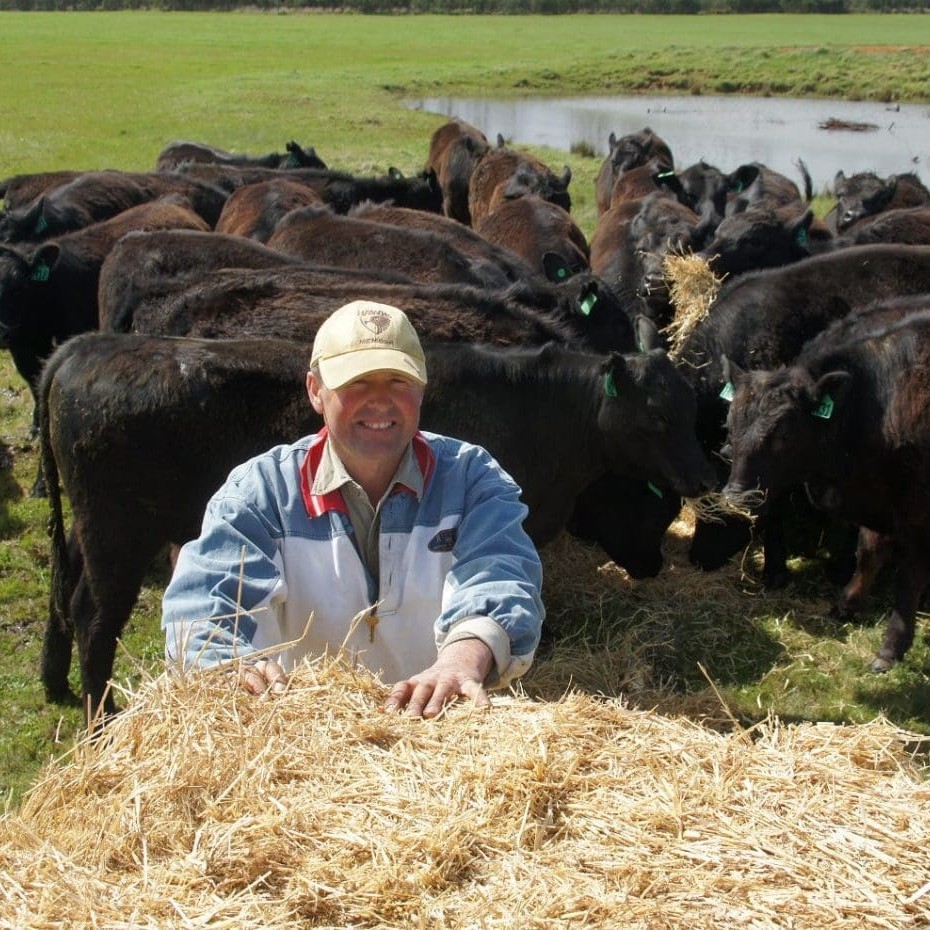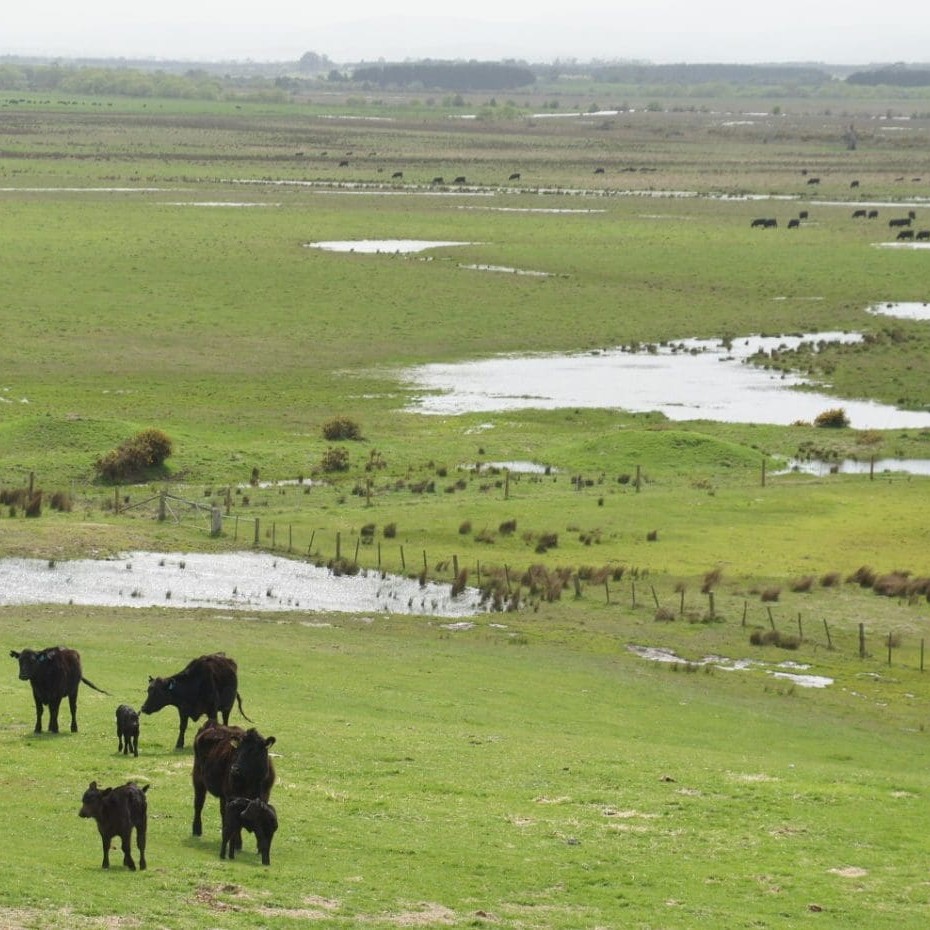A ‘no-frills’, yet high-performance Angus breeding herd is helping better utilise low-lying marshy country where there is little application for sheep on a northern Tasmanian grazing property.
The Gunn family has run a grazing enterprise, mostly woolcutters, on their northern midlands property Forton for the past 80 years, and for much of that time Angus cattle have provided a solution to problem low-lying areas along the South Esk River.
 Principal Antony Gunn runs about 150 breeders as part of Forton Pastoral Co, which neighbours the large 16,000 head Tasmania feedlot near Powranna.
Principal Antony Gunn runs about 150 breeders as part of Forton Pastoral Co, which neighbours the large 16,000 head Tasmania feedlot near Powranna.
While much of the management effort focusses on Forton’s 6000 fine/medium wool sheep, ewes from which can cut anywhere from 5.8 and 6.8kg a year, the cattle side of the operation is run very much on ‘low-maintenance’ lines.
“The cattle are really a low-input sideline to our woolgrowing business, and in order to balance the two, they have to be run fairly tough,” Mr Gunn said.
While the property sits in a moderate 23 inch (580mm) average annual rainfall belt, as can be seen in the photos published below, it includes extensive low-lying flood-out areas along the South Esk River that are not suitable for sheep production, especially over winter. A week before this picture was taken a month ago, the entire area was under water, and it’s possible for the country to flood at any time of year.
Forton includes a diverse range of country, from quality improved pasture country where the woolgrowers are run to more than 800ac (300ha) of this rougher, low-lying river frontage which is unimproved, basically carrying native pastures, sags, some clover and edible weeds.
“The cattle side of our business fills an important niche in making best use of that low-lying country – we’ve found them very handy to have,” Mr Gunn said. “They do remarkably well on it.”
 In years when the river doesn’t flood, the cattle will winter-down on the low lying country, but otherwise might come up for a spell on higher ground.
In years when the river doesn’t flood, the cattle will winter-down on the low lying country, but otherwise might come up for a spell on higher ground.
In a big spring season like this year, older cows will spend some time on better country during the spring flush to clean-up paddocks before heading back onto the low-lying flats.
“Keeping the cattle side of our business simple is the key. Our sheep operations dictate that we can’t spend a lot of time on them – they need to be easy-care, and low maintenance,” Mr Gunn said.
Depending on the season, mature breeders might get a little grassy hay as roughage during the tougher end of the year, but are otherwise not routinely supplemented.
Mr Gunn estimated that no more than five percent of the enterprise’s total management resource is spent each year on the cattle side of the business.
The Gunn’s run their cattle operation as a simple ‘calf factory’, resisting the temptation to utilise some of their better country used for wool production to grow-out steers – instead they sell their entire calf crop each year (minus breeder replacements) as weaners, off their mothers.
Most of the steer calves are sold out of the paddock in March/April to backgrounders who grow them out to feedlot entry weights, often sold back to the Tasmania feedlot, next door to Forton. Heifers are mostly grown out to grassfed yearling slaughter weights.
Weaned heifers are the only exception to the rule about access to better country, being put onto better improved elevated pasture for a period to get them up to mating weights, in order to calve at two years of age.
Heavy culling on fertility
The fertility retention policy used by the Gunns is a simple: ‘No calf, no life.’ Having only 150 breeding units to work with, the Forton cattle program cannot afford to carry non-paying passengers.
As a result, mature cows are regularly delivering 98pc conceptions at preg-testing, after an eight-week controlled mating, using three or four single-sire mated herds.
The Gunns aim to maintain a younger age profile within the herd, removing females at eight years of age. Cull cows go straight to the meatworks.
Weaning weights in a typical year average around 270kg at 7-8 months, and heifers around 250kg. With the Tasmania feedlot now looking for feeders starting around 450kg, the more weight in weaned calves the better.
This year’s heifers are being mated about now, for calving around the first week of August next year. First-calf heifers normally produce calving rates around 70pc, but that might be exceeded this year, given the body condition they are in following recent rain, Mr Gunn said.
Despite the compact scale of the Forton cattle operation, the Gunns’ seek-out good, all-round performers as herd bull replacements, being repeat buyers from Cluden-Newry, a well-known family-run Angus seedstock business located at Jessiefield in Tasmania's central north, about 25km south of Launceston.
The Gunns try to balance growth, doing-ability and maternal traits with positive Breedplan figures for marbling and meat quality. Breedplan data is balanced with visual assessment for type and structure. The business has paid $6000-$8000 for the right style of bulls in the past.
While there is a little fluke challenge on the lower country and the cattle can be exposed to a moderate worm burden, cattle are tested seasonally and drenched accordingly.
Some of the higher country, when utilised for cattle can produce a little grass tetany, managed with roughage.
Let-down fences are an important feature on Forton’s lower flood-prone paddocks, which keeps post river flood maintenance to a minimum. Even after major floods two years ago, the lower paddocks required only half a day’s fencing work to bring them back into shape, after the water had passed.
